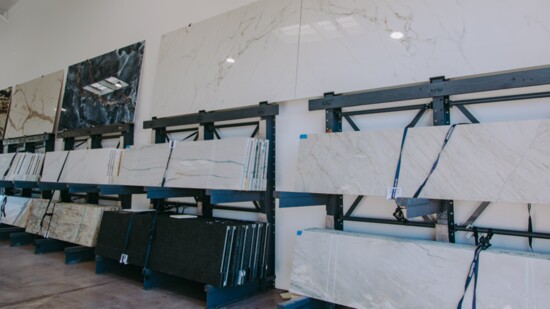Each piece of natural stone is unique, just like your home. Thus, choosing the right material is a decision you should not take lightly. Christian Coetzee, owner of Stone Solutions – a company that has served Hawai’i for almost 20 years – shares how to avoid the most common mistakes when bringing your home designs to life.
To start, you should decide in what environment the material is going to be. Ask yourself, will it receive direct sunlight? Is it going to be in a place with heavy water usage? Perhaps in a location where people are cooking and baking? Will it be outdoors or indoors?
Most people go and select the material purely based on the color or aesthetics, but then get frustrated by its limitations. Some materials can stand up to hot oil, others get bleached by the sunlight, and a lot of materials can't stand up to an acidic environment. “You have to pick something that can withstand the usage,” Christian says. “Otherwise, a year down the line, you’ll feel like you should’ve picked something else because now, the material is stained, and you have to pay the price for maintenance.”
According to Christian, you should never put marble in a kitchen. Why? It requires too much care and the staining factor is high due to acid burns like vinegar and lemon. It’s the same for some softer stones like travertine. If you are going to do a lot of cooking, consider a denser material that is man-made, like Taj Mahal or quartzite. “The general rule of thumb is – for the most part – the natural lighter materials look white or soft yellow. To avoid doing a lot of maintenance, gravitate away from them,” Christian says.
If you do not want your design to look outdated after a couple of years, don’t go for the trending colors. Most neutral hues are timeless, like Taj Mahal or subdued tones. “If people want to sell a home, then it might be ideal not to pick something super busy that has a date on it,” Christian shares. Instead, the more monotone the color or pattern, the longer it’ll stay current.
Also, don’t pick your floor covering by looking at just one tile because it doesn’t represent everything that comes in the box. Instead, unpack a box of that tile and lay it out to see how all the different tiles work together. That way you won’t be disappointed.
People often come to Christian with cabinet drawings that are out of the size bounds of the material and end up paying more for their projects. To avoid this, he recommends they work on their cabinet and stone selection first, and then do tile and paint. Never the other way around. “If you already have a cabinet tile and paint picked, and then try to find a stone that fits your idea, you might get stuck because the stone selection isn't always that wide,” he says.
Always keep in mind that your cabinets should be conducive to the size of the stone. “A lot of stone products are not longer than 10 feet, yet, people come with cabinet drawings that are 10 feet five inches or 11 feet. This makes for a very unsightly installation because now they have to piece the materials together,” Christian warns. Pick your cabinet color and your stone, and then work with a cabinet designer. See if the designer can bring the cabinet layout within the bounds of the material, it will make for a better installation.
Consider that things take a bit of time on our island. So don’t wait till the very last moment to try to secure materials or to track down somebody who can install it. Especially because most contractors give free estimates. A couple of months before you're even ready to start, get on somebody's radar, as most contractors are booked for several months at a time. “If you wait till the last minute, the amount of contractors that'll be willing to do your job will be very small, especially those that do high-quality installation,” Christian says.
When deciding what contractor you should work with, research who's got a good reputation. Line somebody up a few months in advance and wait for them. Even if it means you buy the cabinets and store them for a month. Then, as soon as your stone installer is ready, they can do the installation. Don’t pick someone in a rush. If a contractor is willing to do the job immediately, ask yourself why are they available when everybody else is booked up.
A lot of materials at Stone Solutions come from Brazil, India and Italy. Brazil is the main driving force in the stone market right now, as it has some of the nicest veins of material. Yet, the new thing in the stone market that solves a lot of the maintenance issues is porcelain. “Hawai’i is catching up to the porcelain trend that is all over the mainland and even worldwide, especially huge, beautiful, walk-in showers. Porcelain doesn't wear and tear, it doesn't absorb water or stain. You don't need to seal it, and it can be indirect sunlight. So most of your applications' problems are solved by this new product,” Christian shares.
Learn more at Hawaii-Stone.com.
"You have to pick something that can withstand the usage."
“Hawai’i is catching up to the porcelain trend that is all over the mainland."








